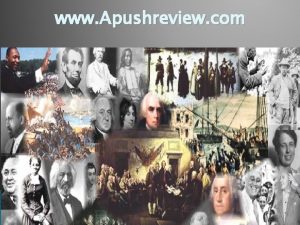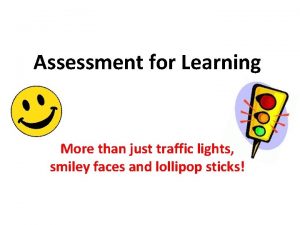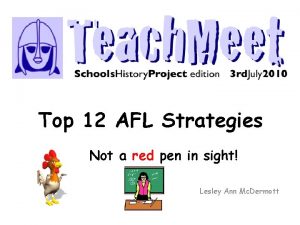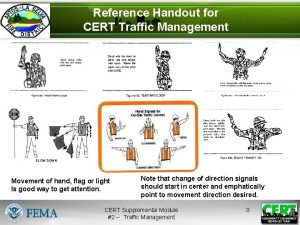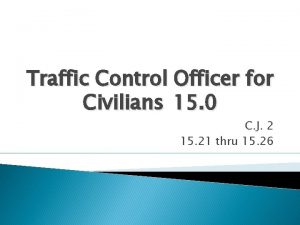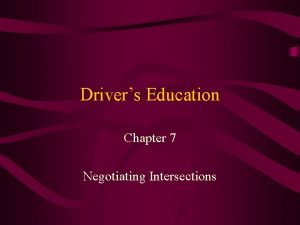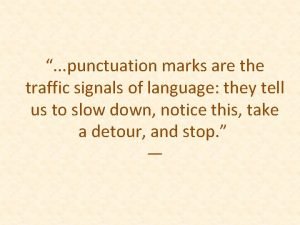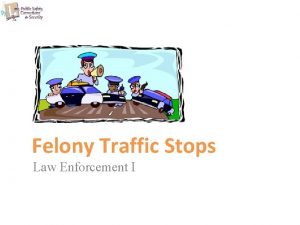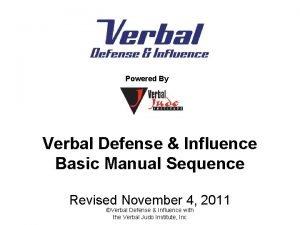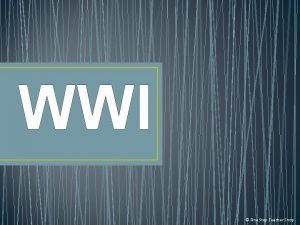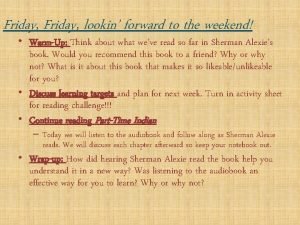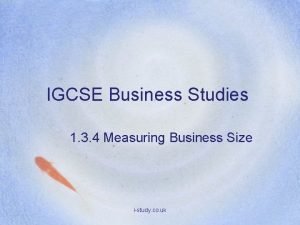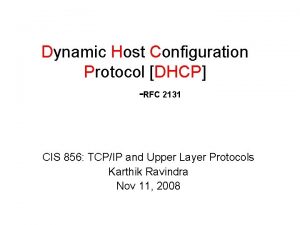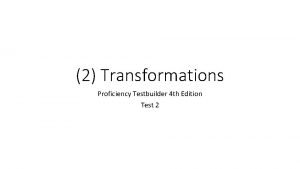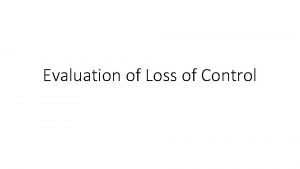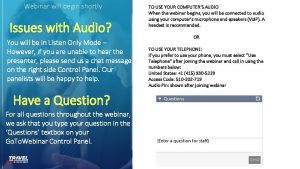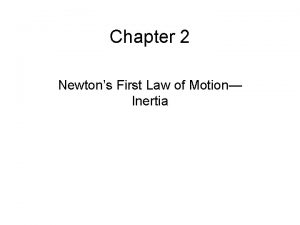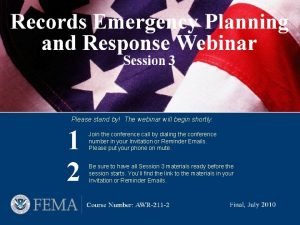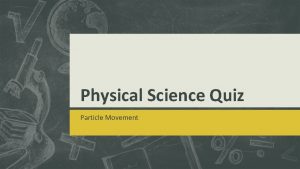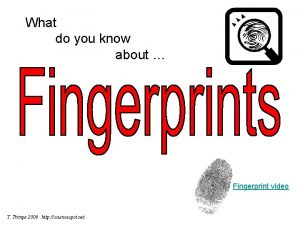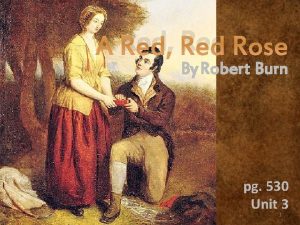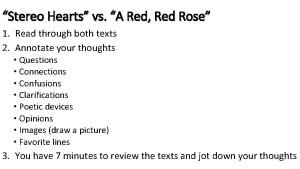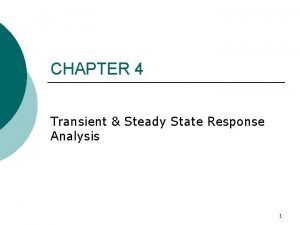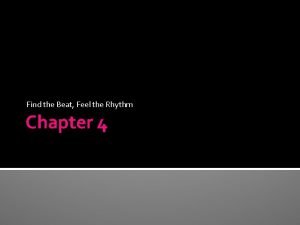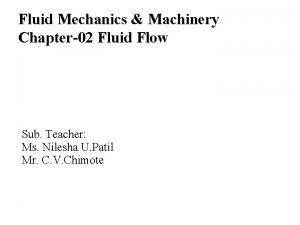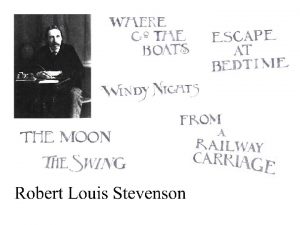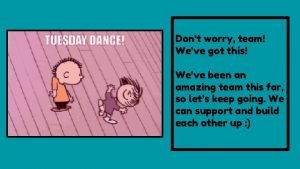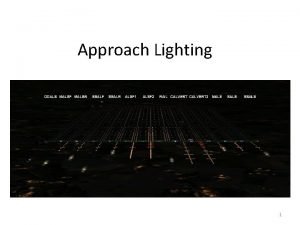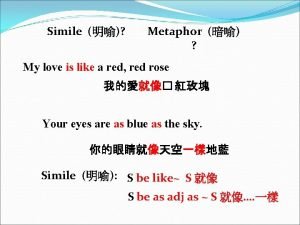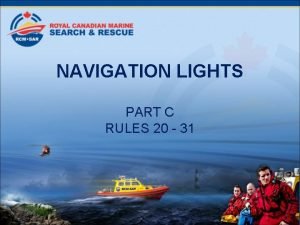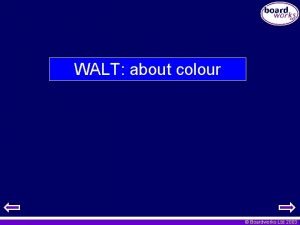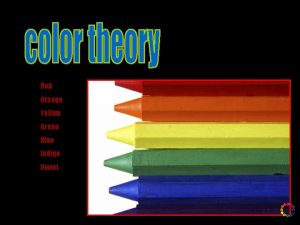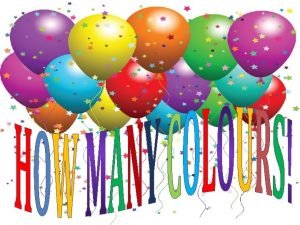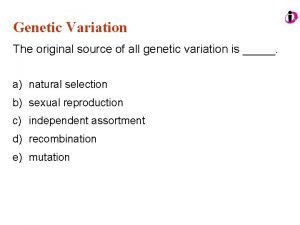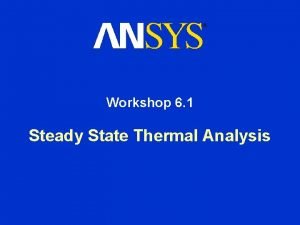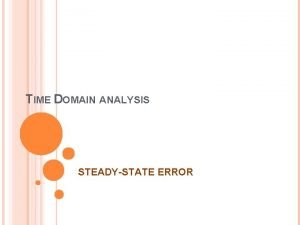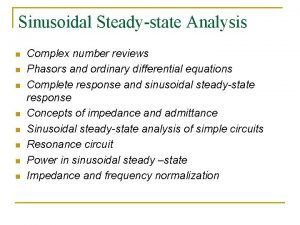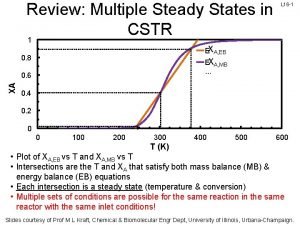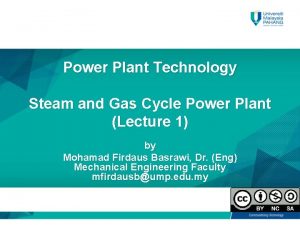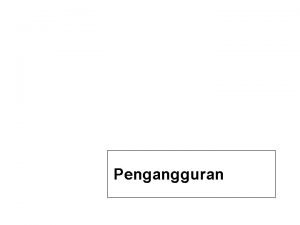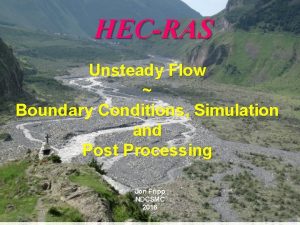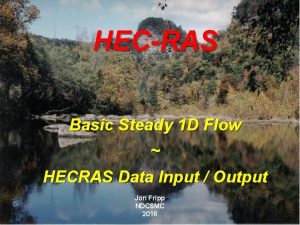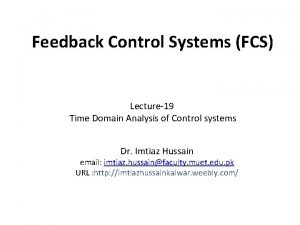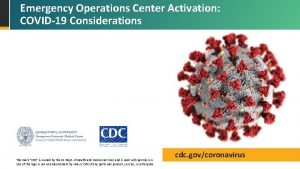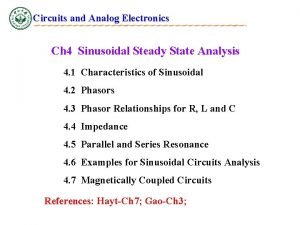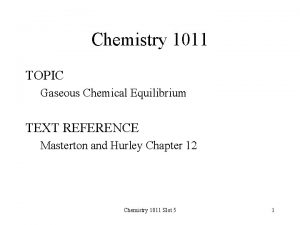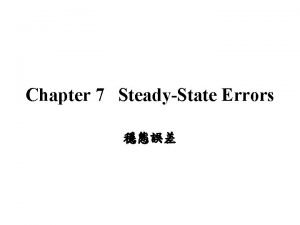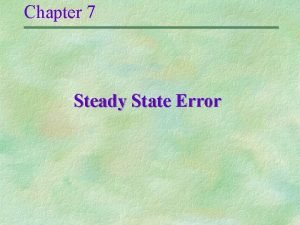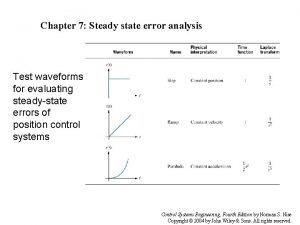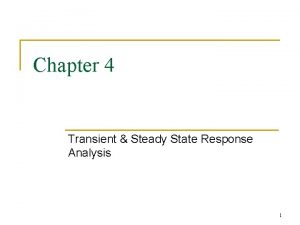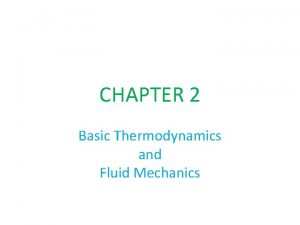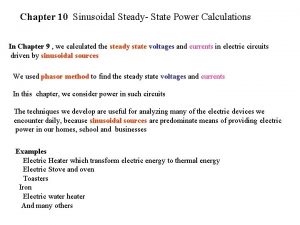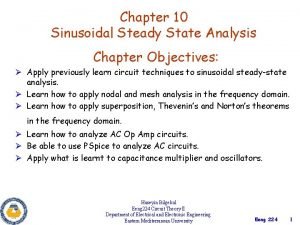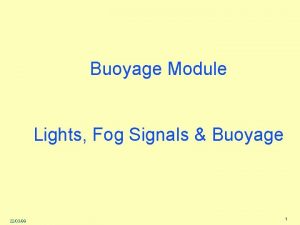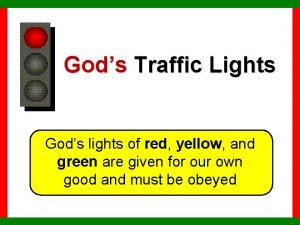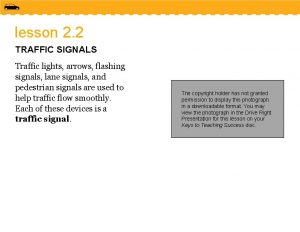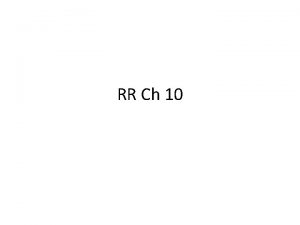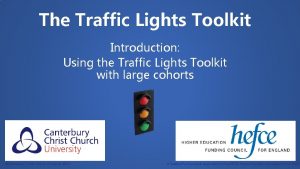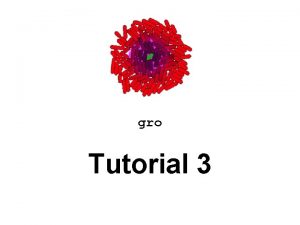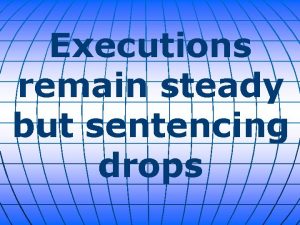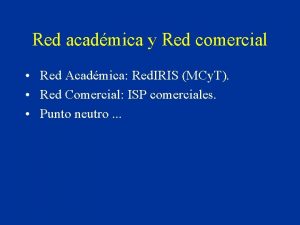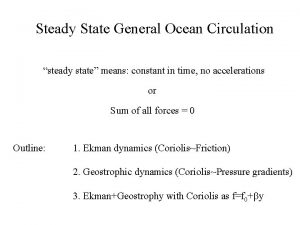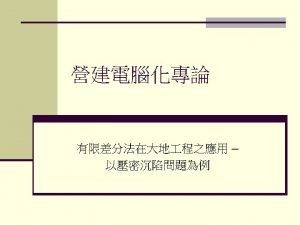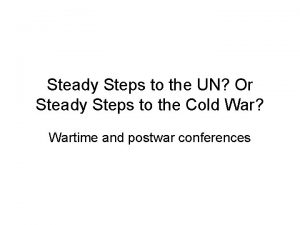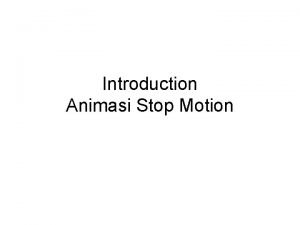Traffic Signals Steady lights Red stop and remain



















































































- Slides: 83

Traffic Signals Steady lights § Red –stop and remain stopped as long as the signal is red § Yellow - a steady yellow light or arrow indicates that the light is about to change § Clear the intersection § Green – go IF the way is clear 1

Traffic Signals Flashing Lights Flashing Red STOP before entering the intersection Flashing Yellow - Caution dangerous intersection 2

Traffic Signals Arrows You may proceed in the direction of the green arrow You may NOT proceed in the direction of the red arrow 3

Testing Your Knowledge When this traffic light is RED a. STOP and remain stopped until the light changes b. Slow down and proceed with caution c. Yield to traffic in the intersection 4

Testing Your Knowledge a. STOP and remain stopped until the light changes Correct! When the traffic light is RED, you must stop and remain stopped until the light turns GREEN. You may turn right on red after stopping unless there is a sign prohibiting it. You may turn left on red after stopping if you are on a one-way street and moving to another one-way street unless there is a sign prohibiting it. 5

Traffic Signs Right Turn on Red At some intersections you may turn right while the traffic light is red § BEFORE turning STOP § Check for traffic and pedestrians You may NOT turn right on red if one of these signs is present 6

Traffic Signs Left Turn on Red Left turn on red is permitted from one-way street to another one-way street You must: • Stop and • Yield to other traffic and pedestrians You may NOT turn left on red if there is a sign prohibiting it 7

Testing Your Knowledge You are allowed to turn right or left at a red light after stopping at all intersections a. True b. False 8

Testing Your Knowledge b. false Correct! Right turn on red can be made at an intersection that does NOT have a prohibitive sign or a red arrow. Left turn on red can only be made from one-way street to another one-way street. 9

Traffic Signs - Colors have Meaning Red — prohibitive or stop Blue — motorist services Green — guide information, such as direction or guidance signs Yellow —general warning 10

Traffic Signs - Colors have Meaning Orange — construction and maintenance work White — regulatory signs Brown —recreational and cultural interest Fluorescent Optic Yellow —school zones, school crossings and pedestrian crossings 11

Testing Your Knowledge Red on a sign indicates: a. caution b. prohibitive c. construction zone 12

Testing Your Knowledge b. Prohibitive Correct! RED – means stop or prohibited Examples: § Stop § No Right Turn § Do Not Enter 13

Testing Your Knowledge A sign with a White background a. warning sign b. traffic law c. guide sign 14

Testing Your Knowledge b. Traffic law Correct! Signs with a white background are regulatory and state traffic laws 15

Testing Your Knowledge Orange on a sign indicates: a. Construction/road work b. Regulatory (the law) c. Services 16

Testing Your Knowledge a. Construction/road work Correct! The color orange lets the driver know there is construction ahead or you are entering a work zone 17

Testing Your Knowledge A Yellow sign indicates a. construction b. services c. general warning 18

Testing Your Knowledge c. General warning Correct! Yellow signs are general warning signs. Drivers should proceed with caution Merge Pedestrian Crossing 19

Traffic Signs - shapes Having Meaning Octagon —Stop signs Triangle —Yield signs Diamond — Warning Pentagon — School and School Crossings Pennant — Advance warning of No Passing Zones 20

Traffic Signs - shapes Having Meaning Rectangle — Regulatory or Guide Vertical indicates Regulatory Horizontal indicates directions or information Round - advance warning of Railroad Crossing Crossbuck – Railroad Crossing (same as a yield sign) 21

Testing Your Knowledge Because this sign is diamond shaped, we know it means a. school zone b. the law (regulatory) c. caution 22

Testing Your Knowledge c. caution Correct! A diamond shaped sign does indicate a general warning! Deer Crossing 23

Testing Your Knowledge A round sign indicates a. warning b. yield c. rail road crossing ahead 24

Testing Your Knowledge c. rail road crossing ahead Correct! A round sign is an advanced warning of a RR crossing The crossbuck should be treated as a yield sign at a RR crossing 25

Traffic Signs Warning Signs Give advance warning of hazards to allow drivers time to safely minimize risks Yellow General Warning Orange Construction/ Work Zone 26

Traffic Signs Note the difference between these signs! A school crossing sign is 5 sided (pentagon) A pedestrian crossing sign is a diamond shaped sign Winding road Slippery when wet – slow down when road surface is wet 27

Traffic Signs Guide Signs Green GUIDE drivers to their destination by identifying routes well in advance 28

Traffic Signs Information Signs INFORM drivers of motorist services and recreational facilities Services - Blue Recreation/Historical Landmarks- Brown 29

Traffic Signs Regulatory Signs REGULATE the speed and movement/direction of traffic Red – Stop or Prohibitive White Regulations 30

Testing Your Knowledge The orange cone indicates a. construction b. warning – intersection ahead c. services ahead 31

Testing Your Knowledge a. construction Correct! The color orange indicates construction or work zone These cones are used to channel traffic thru the work zone 32

Testing Your Knowledge This sign indicates a. no left turn b. left turn only c. sharp curve to the left 33

Testing Your Knowledge a. no left turn Correct! This is a NO LEFT TURN sign The shape (rectangle) and color (white) of this sign identify it as a regulatory sign. The RED slash indicates the action shown is prohibited. 34

Traffic Signs What does the sign mean? Review the Virginia Driver’s Manual Divided highway begins Right curve- side road Divided highway ends Right and left curves Slippery when wet SHARP right and left curves Winding Road Low clearance 35

Traffic Signs What does the sign mean? No passing zone ahead LEFT LANE HOV-2 ONLY 6 -8 AM Lane reserved for high occupancy vehicles Slow moving vehicle travels 25 mph or less Crossbuck/gate down Stop and remain stopped until the gate goes up MON-FRI Construction work zone ahead 36

Testing Your Knowledge This sign indicates a. two-way traffic/ keep right b. divided highway begins c. divided highway ends 37

Testing Your Knowledge a. two-way traffic Correct! This is a warning sign indicating two-way traffic The driver should keep right 38

Testing Your Knowledge If you see this sign, you know a. it is a warning sign b. only vehicles with at east two occupants are allowed in this lane between 6: 30 am and 9: 30 am LEFT LANE HOV-2+ ONLY 6: 30 -9: 30 AM MON-FRI 39

Testing Your Knowledge b. only vehicles with at east two occupants are allowed … Correct! This sign is a regulatory sign that indicates it is against the law to be in that lane between 6: 30 – 9: 30 AM, Monday through Friday if there are not at least 2 occupants in your vehicles LEFT LANE HOV-2+ ONLY 6: 30 -9: 30 AM MON-FRI 40

Virginia Learner’s Permit General Knowledge Test 80% needed to pass (20 out of 25 correct) Virginia Driver’s Manual -Sections 2, 3 & 4 Topics § Pavement Markings § Safe Driving § Speed Limits § Sharing the Road § Parking § Use of Lights § Right of Way § Changing Lanes/Passing § Turning § Dangerous Driving Behaviors § Signals § Maintaining Space § § Aggressive Driving § Distracted § Alcohol/Drugs & Driving § Drowsy Safety Belts, Air Bags & Child Safety Seats 41

Pavement Markings Lesson 2 Understanding Pavement Markings 42

Pavement Markings Yellow Line = Two-way Traffic White Line = One-way Traffic Solid Line = No Passing Broken Line = Pass With Caution Is this a one-way or two-way road? Would passing be allowed? 43

Pavement Markings Yellow Line Two way traffic pass with caution Traffic Flow Two way traffic no passing 44

Pavement Markings White Lines One-way traffic Broken - pass with caution Traffic Flow Stop line Left turn only - arrow No passing - solid line 45

Pavement Markings Multi-Lane ONE WAY – pass with caution TWO WAY – no passing over solid lines 46

Pavement Markings Triangles painted on the pavement show that you must yield 47

Pavement Markings Arrows Indicate the Flow of Traffic This lane may continue straight or turn left This lane must turn left 48

Pavement Markings Shared Left Turn Lane § Traffic from both directions uses this lane to turn left § Do not travel more than 150 feet in this lane 49

Pavement Markings Diamond Shaped Pavement Marking § HOV § Bus Lanes § Bicycle Lanes 50

Testing Your Knowledge When approaching this pavement marking a. stop b. yield c. proceed with caution 51

Testing Your Knowledge b. yield Correct! Triangles painted on the pavement mark an area in which you must yield 52

Testing Your Knowledge If you are driving in this lane, you must a. turn left b. turn right 53

Testing Your Knowledge a. turn left Correct! This is a shared left turn lane – Vehicles in this lane must turn left 54

Testing Your Knowledge This roadway is a. one way – no passing b. one way – passing allowed c. two way – passing allowed 55

Testing Your Knowledge b. one way – passing allowed Correct! White lines indicate one-way traffic and broken lines indicate passing is allowed 56

Understanding the Virginia Driver’s Manual Lesson 3 Right of Way 57

Right of Way Concepts § Right-of-Way is not a right or privilege – it must be given! § Right of Way is determined by a set of rules § Drivers must understand right-of-way rules governing § Intersections § Merges § Special conditions 58

Right–of–Way Concepts: Intersections Determine Who Should YIELD In The Following Situations § Controlled Intersections § Uncontrolled Intersections § Single or two-lane roads § intersecting with multiple-lane roads § When turning left § “T” Intersections § Railroad grade crossings 59

Right–of–Way Concepts: Intersections Controlled Intersections A controlled intersection has signs or signals to regulate the flow of traffic § Signs and/or signals § determine who should yield § regulate the flow of traffic and pedestrians 60

Uncontrolled or 4 -Way Stop Intersections § An uncontrolled intersection has NO signs or signals to regulate the flow of traffic § A 4 -way stop has a stop sign at each corner First Car Rule Same Time Rule Vehicles approaching an intersection must yield to vehicles already in the intersection When two or more vehicles approach an intersection at approximately the same time, the driver of the vehicle on the left shall yield the right-of-way to the vehicle on the right 61

Uncontrolled or 4 -Way Stop Intersections In these illustrations, the Blue Car must yield the right-of-way 62

Testing Your Knowledge If both of these vehicles arrive at this uncontrolled intersection at the same time, who must yield? a a. Car a b b. Car b 63

Testing Your Knowledge a. Car a Correct! At and UNCONTROLLED INTERSECTION or 4 WAY STOP if two vehicles approach at the same time, the vehicle on the left must yield 64

Right–of–Way Concepts: Intersections T-Intersections At a T-intersection, the vehicle on the side street must stop and yield right of way Traffic Circles Vehicles entering the traffic circle shall yield to vehicles already in the intersection 65

Right–of–Way Concepts: Intersections T-Intersections In the illustration above, the Blue Car must yield the rightof-way Traffic Circles In the illustration above, the White and Yellow Cars must yield the right-of-way 66

Testing Your Knowledge Who must yield at a traffic circle (roundabout)? a. Vehicles in the circle b. Vehicles entering the circle 67

Testing Your Knowledge b. Vehicles entering the circle Correct! Vehicles entering a traffic circle must yield to vehicles already in the circle 68

Right–of–Way Concepts: Emergency Vehicles Yield the Right-of-Way to Emergency Vehicles must yield the right-of-way to police, fire, and rescue vehicles using a siren and/or flashing lights If traffic is congested and prevents moving to the right edge of the road, adjust lane position and leave a clear path for the emergency vehicle to pass On an undivided highway, all traffic must pull over to the edge of the road and allow the emergency vehicle to pass 69

Right–of–Way Concepts: Pedestrians Yield the Right-of-Way to Pedestrians § Intersections § Crosswalks § Making Right Turns § Making Left Turns 70

Right–of–Way Concepts: School Bus Yield the Right-of-Way to School Buses All traffic must stop for a school bus with flashing red lights and an extended stop sign UNLESS the vehicles are traveling on the opposite side of a highway separated by a physical barrier or unpaved median area 71

Right–of–Way Concepts: School Bus If a School Bus is loading or unloading students on a two lane road, traffic from both directions must stop At an intersection, all traffic must stop In these illustrations, the RED cars must STOP and YIELD Right-of-Way 72

Right of Way Concepts: School Bus Vehicles traveling on the opposite side of a divided highway separated by a barrier or unpaved median do not have to stop In this illustration, the RED cars must STOP and YIELD Right-of-Way 73

Railroad Crossings Railroad crossings are specialized intersections Passing and overtaking is not permitted Virginia law requires certain vehicles (e. g. , school buses, oil tankers, etc. ) to stop at all railroad crossings If you follow one of these “Must STOP Vehicles”, be prepared to stop, since you cannot pass or overtake them at an intersection 74

Railroad Crossings Advance warning signs – a round, yellow sign with a black “ RR” indicates a highway-rail crossing is ahead - be prepared to stop Pavement markings – “RR” painted on the pavement - be prepared to stop Crossbuck signs are like yield signs – drivers must YIELD to trains • Slow down and be prepared to stop when you see the crossbuck sign. • A sign below the crossbuck indicates the number of tracks drivers must cross 75

Railroad Crossings Flashing red lights and warning bells § STOP - if you see flashing red lights or hear warning bells § Gates - flashing red lights and/or bells STOP Never go around the gates, it’s against the law § Flag operator - Proceed only when given the “all clear” signal § Train whistle - STOP if you hear a train whistle, or see a train Cross when the gates are up, the lights and bells stop, and all tracks are clear in both directions! 76

Testing Your Knowledge You must always stop for a stopped school bus with it flashing lights and stop arm unless a. You are at an intersection b. There are no children or unloading c. There is a median between you and the bus 77

Testing Your Knowledge c. There is a median between you and the bus Correct! You must always stop for a school bus with flashing lights and a stop arm unless there is a median between you and the bus 78

Testing Your Knowledge When you approach this sign, you should a. stop b. proceed with caution c. slow down, look and listen for trains 79

Testing Your Knowledge c. slow down, look and listen for trains Correct! The crossbuck should be regarded as a yield sign Drivers should slow down, listen and look for trains and be prepared to stop 80

Speed Limits A speed limit is the maximum legal speed you can travel on a road under ideal conditions Basic Speed Limits • School, Business or Residential Zones 25 MPH • Rural Expressway (Interstates) 65 MPH • Rustic Roadways 35 MPH • All other roadways 55 MPH UNLESS OTHERWISE POSTED 81

Speed Limits The 2010 Virginia General Assembly raised the maximum allowable speed limit in Virginia to 70 MPH. § These 70 MPH speed zones will only apply to roadways specifically designated by VDOT. § Driving above 80 MPH will still constitute reckless driving. 82

Virginia Driver Education Go to: http: //www. dmvnow. com/dmvweb/kats /sne_intro. asp and take the general knowledge practice test.
 Fluctuate adverb
Fluctuate adverb Old lights vs new lights
Old lights vs new lights Jonathan edwards apush definition
Jonathan edwards apush definition Communicative signals and informative signals
Communicative signals and informative signals Communicative signals and informative signals
Communicative signals and informative signals Communicative and informative signals
Communicative and informative signals Traffic lights assessment for learning
Traffic lights assessment for learning Traffic lights afl
Traffic lights afl Traffic hand signals
Traffic hand signals Traffic whistle signals
Traffic whistle signals An uncontrolled railroad crossing
An uncontrolled railroad crossing Traffic signals of language
Traffic signals of language Incomina
Incomina All traffic solutions traffic cloud
All traffic solutions traffic cloud Felony traffic stop
Felony traffic stop Felony traffic stop vehicle positioning
Felony traffic stop vehicle positioning 5 step verbal judo
5 step verbal judo De lin institute of technology
De lin institute of technology One stop teacher shop
One stop teacher shop Why do junior and rowdy climb the tree
Why do junior and rowdy climb the tree Christ is risen from the grave come awake
Christ is risen from the grave come awake Why business remain small igcse
Why business remain small igcse Dhcpnak
Dhcpnak Susan is far superior to me in terms of technical knowledge
Susan is far superior to me in terms of technical knowledge Fear anger remain
Fear anger remain Fear anger remain
Fear anger remain Fear anger remain
Fear anger remain The webinar will begin shortly please remain on the line
The webinar will begin shortly please remain on the line Example of law of inertia
Example of law of inertia Awaiting your reply i remain yours sincerely
Awaiting your reply i remain yours sincerely When dishes remain on a table when you yank
When dishes remain on a table when you yank The webinar will begin shortly please remain on the line
The webinar will begin shortly please remain on the line What causes a balloon to remain inflated? *
What causes a balloon to remain inflated? * Radial vs ulnar loop
Radial vs ulnar loop The webinar will begin shortly please remain on the line
The webinar will begin shortly please remain on the line A red red rose tone
A red red rose tone A simile in stereo hearts
A simile in stereo hearts Transient and steady state response in control system
Transient and steady state response in control system Your love is amazing steady and unchanging
Your love is amazing steady and unchanging Type of spontaneous musical invention
Type of spontaneous musical invention Turtles are wonderful creatures subject and predicate
Turtles are wonderful creatures subject and predicate Steady breaking and wombing
Steady breaking and wombing Fluid pattern
Fluid pattern Love is amazing
Love is amazing The lights from the parlour and kitchen shone out
The lights from the parlour and kitchen shone out When was bright lights of sarajevo written
When was bright lights of sarajevo written Starbourd
Starbourd The lights from the parlour and kitchen shone out
The lights from the parlour and kitchen shone out Rail airport lighting
Rail airport lighting Simile and metaphor
Simile and metaphor Red gri
Red gri White over red pilot ahead
White over red pilot ahead Old news poetic devices
Old news poetic devices Why does a red ball look red
Why does a red ball look red Indigo vs violet
Indigo vs violet Red orange yellow green blue purple pink brown black white
Red orange yellow green blue purple pink brown black white The original source of all genetic variation is _____
The original source of all genetic variation is _____ Steady state thermal analysis ansys
Steady state thermal analysis ansys Steady state error
Steady state error Sssf thermodynamics
Sssf thermodynamics Sinusoidal steady state
Sinusoidal steady state Multiple steady states in cstr
Multiple steady states in cstr Steam cycle
Steam cycle Contoh pengangguran alamiah
Contoh pengangguran alamiah Mitokondre
Mitokondre Contoh aliran steady dan unsteady
Contoh aliran steady dan unsteady Nicole menten
Nicole menten Hec-ras boundary conditions
Hec-ras boundary conditions Steady flow data hec-ras
Steady flow data hec-ras Steady flow process thermodynamics
Steady flow process thermodynamics Steady state response in control system
Steady state response in control system In a normal operations/steady state eoc activation level
In a normal operations/steady state eoc activation level Static error constant formula
Static error constant formula Complex impedances
Complex impedances Steady state vs equilibrium
Steady state vs equilibrium What is steady-state thermal analysis?
What is steady-state thermal analysis? Michaelis menten steady state
Michaelis menten steady state Steadystate error
Steadystate error Steady state error with disturbance
Steady state error with disturbance Steady state error
Steady state error Steady state response
Steady state response What is rothalpy
What is rothalpy Steady state current formula
Steady state current formula Sinusoidal steady state analysis
Sinusoidal steady state analysis


